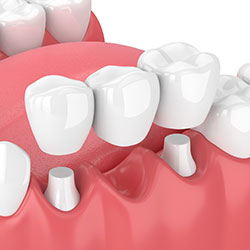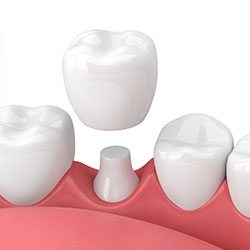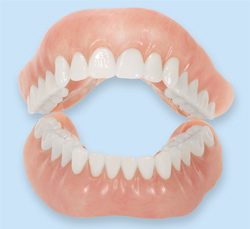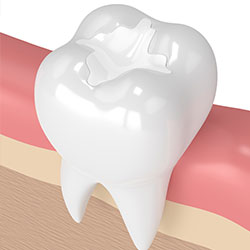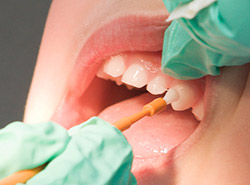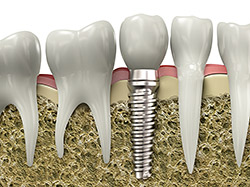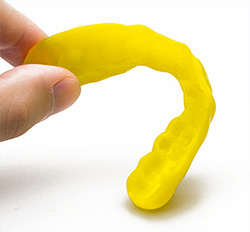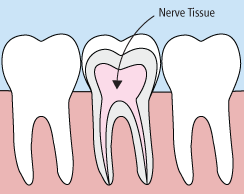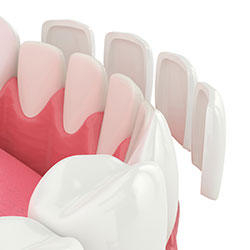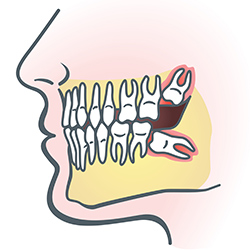Our San Francisco general dentistry experts, Dr. Ben Amini and associates, provide general dentistry services designed to prevent and restore oral health problems affecting the teeth and gums. Although several general dentistry procedures focus on functionality, certain aspects of general dentistry also address the appearance of teeth. Routine checkups or other appointments may include general dentistry services depending on individual risk factors and goals.
Routine checkups, performed at least once every six months for most patients, are used to inspect the teeth and gums and provide general maintenance of the mouth. Our expert in general dentistry in San Francisco looks at the teeth and gums by optical magnification and illumination, with assistance from X-ray technology, which enables identification of problems that may otherwise be invisible. Thorough cleaning, using manual or ultrasonic technology and polishing instruments, keeps teeth looking good and reduces tooth decay risks.
General Dentistry San Francisco
Our expert in general dentistry in San Francisco performs several restorative procedures. Depending on the type and severity of damage present, our dentist may recommend fillings, inlays, onlays, crowns, or other treatments. Tooth replacement with any of several methods is also available. Tooth decay, gum disease, infections, or physical trauma can make these procedures necessary.
Topics on this page
Regular Exams and Cleanings
Dental exams play an essential role in oral and overall health by providing an opportunity for our dentist to find problems and pinpoint treatments when necessary. In addition to oral health problems, such as gum disease and tooth decay, our San Francisco dental exam expert can identify systemic issues that may manifest in the mouth. For example, diabetes, nutrient deficiencies, and cancer can have oral symptoms. When gum disease remains untreated, it can result in passage of bacteria into the blood stream, where the bacteria can cause inflammation in the arteries, heart, and lungs. Dr. Ben Amini and Associate dentists at CitiDent review medical history, medications, allergies, and other personal factors in order to develop a personalized exam for each patient.
Our dentist may spot a variety of issues by examining the mouth visually and with digital X-rays. For example, microscopic cavities may be found so that repair can be performed and more extensive restorations can be avoided. Bite irregularities, if found, may prompt recommendations for Invisalign or other orthodontic treatments. When patients suffer from bruxism without being aware of it, our dentist may discover the issue and advise protective gear so that further damage can be prevented. Finally, our expert in dental exam in San Francisco can recognize potential risk factors so that preventive treatments can be selected.
Dental Exam San Francisco
Our San Francisco dental exam expert examines the mouth by eye to spot issues affecting the teeth and soft tissues. In many cases, our dentist will also perform digital X-rays so that hidden problems can be found and analyzed on computer. If problems are diagnosed, our dentist may recommend treatment or issue a referral to the appropriate medical professional. Treatments may be performed at the same appointment or at a future appointment depending on the procedure and other factors.
Patient education is performed by our expert in dental exam in San Francisco so that patients are confident partners in their oral wellness. Proper brushing and flossing techniques, ideal oral hygiene tools, preventive treatment options, and frequency of dental exams are possible topics of discussion.
Dental Cleaning in San Francisco
At dental cleanings, our San Francisco dental cleaning expert helps patients avoid oral health problems and supports the appearance of their teeth and gums. As a prophylactic treatment, dental cleaning can save patients time, money, and discomfort associated with oral health issues and complications. Dr. Ben Amini and Associate dentists at CitiDent remove plaque and tartar from the teeth, polish the teeth, and apply fluoride as part of the cleaning process, which is usually performed alongside dental exams during checkups.
Patients receive several benefits from having their teeth cleaned by our expert in dental cleaning in San Francisco. Performed regularly, dental cleaning has significant cosmetic value and can reduce the appearance of minor discoloration caused by tobacco, coffee, tea, and wine. Removal of plaque and tartar decreases risks of decay and erosion by reducing bacterial populations and decreasing the accumulated food particles that oral bacteria consume. Although daily brushing and flossing at home is essential for optimal oral health, regular cleanings by our dentist are also necessary for better prevention of gum disease and its complications, such as tooth loss and infections.
Our San Francisco dental cleaning expert uses a variety of instruments to perform several steps during cleanings. To remove plaque and tartar, our dentist uses scaling instruments that are more effective than common toothbrushes. A special brush is employed to clear discoloration from the teeth, and a polishing instrument is used to further enhance appearance. Depending on individual risk factors, our dentist may also recommend preventive treatments after cleaning. Preventive options include fluoride application, which strengthens and protects teeth against decay, and sealants, which guard teeth against erosion and cavities.
Cleanings are fast and comfortable thanks to cutting-edge equipment and the training and experience of our expert in dental cleaning in San Francisco. Although a majority of patients should receive cleanings at least twice per year, some patients may benefit from cleaning on a more or less frequent basis. At a consultation with our San Francisco dentist, patients can learn more about our cleaning process, its benefits, and the frequency with which it should be performed for them.
Bonding
Bonding is a conservative way to repair slightly chipped, discolored, or crooked teeth. During dental bonding, a white filling is placed onto your tooth to improve its appearance. The filling “bonds” with your tooth, and because it comes in a variety of tooth-colored shades, it closely matches the appearance of your natural teeth.
Tooth bonding can also be used for tooth fillings instead of silver amalgam. Many patients prefer bonded fillings because the white color is much less noticeable than silver. Bonded fillings can be used on front or back teeth, depending on the location and extent of tooth decay.
Bonding is less expensive than other cosmetic treatments and can usually be completed in one visit to our office. However, bonding can stain and is easier to break than other cosmetic treatments, such as porcelain veneers. If it does break or chip, tell your doctor. The bonding can generally be easily patched or repaired in one visit.
Bridges
A bridge may be used to replace missing teeth, help maintain the shape of your face, and alleviate stress on your bite.
A bridge replaces missing teeth with artificial teeth, looks great, and literally bridges the gap where one or more teeth may have been. Your bridge can be made from gold, alloys, porcelain, or a combination of these materials and is bonded onto surrounding teeth for support.
The success of any bridge depends on its foundation: the other teeth, gums, or bone to which it is attached. Therefore, it’s very important to keep your existing teeth, gums, and jaw healthy and strong.
Crowns
Crowns can be used to restore the functionality and appearance of teeth that have been damaged. By placing a crown on a tooth, our San Francisco same day crowns experts at CitiDent also reinforces it against potential sources of damage in the future. Today, same-day crowns offer a faster solution for patients who seek the restorative and cosmetic benefits of this treatment. In just one appointment, patients can get results that might take days or weeks if they were to choose traditional crowns.
Same-day crowns offer more convenience compared to traditional crowns, which often require three visits for completion. Whereas traditional crowns require a consultation, another visit for tooth preparation and a third visit for permanent crown placement, same-day crowns offer all of these steps in a single visit to our experts in same day crowns in San Francisco.
Dentures
Dentures are natural-looking replacement teeth that are removable. There are two types of dentures: full and partial. Full dentures are given to patients when all of the natural teeth have been removed. Partial dentures are attached to a metal frame that is connected to your natural teeth and are used to fill in where permanent teeth have been removed. Just like natural teeth, dentures need to be properly cared for. Use a gentle cleanser to brush your dentures, always keep them moist when they’re not in use, and be sure to keep your tongue and gums clean as well.
Extractions
There are times when it is necessary to remove a tooth. Sometimes a baby tooth has misshapen or long roots that prevent it from falling out as it should, and the tooth must be removed to make way for the permanent tooth to erupt. At other times, a tooth may have so much decay that it puts the surrounding teeth at risk of decay, so your doctor may recommend removal and replacement with a bridge or implant. Infection, orthodontic correction, or problems with a wisdom tooth can also require removal of a tooth.
When it is determined that a tooth needs to be removed, your dentist may extract the tooth during a regular checkup or may request another visit for this procedure. The root of each tooth is encased within your jawbone in a “tooth socket,” and your tooth is held in that socket by a ligament. In order to extract a tooth, your dentist must expand the socket and separate the tooth from the ligament holding it in place. While this procedure is typically very quick, it is important to share with your doctor any concerns or preferences for sedation.
Once a tooth has been removed, neighboring teeth may shift, causing problems with chewing or with your jaw joint function. To avoid these complications, your dentist may recommend that you replace the extracted tooth.
Fillings
Dental fillings may be used to restore teeth after damage has been caused by decay or physical trauma. Although mercury amalgam fillings were long the standard option offered by dentists, tooth-colored fillings are available to modern patients who want to preserve their looks after having their teeth repaired. A variety of other advantages are also associated with tooth-colored fillings, but both types of fillings offer vital restoration when it becomes necessary.
Dental fillings are recommended for repairing damage that is not extensive enough to warrant the use of inlays, onlays, crowns, or extraction. By leaving more of the tooth structure intact, our San Francisco dental fillings experts also let patients retain the natural strength of their own teeth for the sake of function and appearance. Because the area immediately surrounding the decay is filled as well, patients are better protected from future damage in these vulnerable areas.
Our experts in dental fillings in San Francisco may recommend mercury amalgam or tooth-colored fillings to patients. Mercury amalgam fillings are often more affordable, but they may place tooth structure at risk in the long term by expanding and contracting with temperature fluctuations. By contrast, tooth-colored fillings resist expansion and contraction. Furthermore, tooth-colored fillings better support tooth strength because they require less drilling for placement. Of course, many patients choose tooth-colored fillings for their clear aesthetic advantages.
Filling placement by our San Francisco dental fillings experts begins with an X-ray to determine the location and extent of damage. After removing the damaged portion of the tooth and the area immediately around it based on the type of filling being used, our dentist places the filling material and cures it for permanence. Finally, our dentist polishes the new filling to ensure comfort, safety, and optimal appearance.
Our dentist in San Francisco can also replace fillings for patients who want to renew old restorations or switch to tooth-colored fillings from mercury amalgam ones. At a consultation with our experts in dental fillings in San Francisco, patients can learn more about how this treatment is used.
Fluoride
Fluoride is effective in preventing cavities and tooth decay and in preventing plaque from building up and hardening on the tooth’s surface. A fluoride treatment in your dentist’s office takes just a few minutes. After the treatment, patients may be asked not to rinse, eat, or drink for at least 30 minutes in order to allow the teeth to absorb the fluoride. Depending on your oral health or your doctor’s recommendation, you may be required to have a fluoride treatment every three, six, or 12 months.
Implant Restoration
If you are missing teeth, it is crucial to replace them. Without all your teeth, chewing and eating can destabilize your bite and cause you discomfort. When teeth are missing, your mouth can shift and even cause your face to look older. Implants are a great way to replace your missing teeth, and if properly maintained, can last a lifetime!
An implant is a new tooth made of metal and porcelain that looks just like your natural tooth. It’s composed of two main parts: one part is the titanium implant body that takes the place of the missing root, and the second part is the tooth-colored crown that is cemented on top of the implant. With implant treatment, you can smile confidently knowing no one will ever suspect you have a replacement tooth.
In addition to tooth replacement, implants may be used to anchor dentures, especially lower dentures that tend to shift when you talk or chew. For patients with removable partial dentures, implants can replace missing teeth so you have a more natural-looking smile.
Mouthguards
Whether you wear braces or not, protecting your smile while playing sports is essential. Mouthguards help protect your teeth and gums from injury. If you participate in any kind of full-contact sport, the American Dental Association recommends that you wear a mouthguard. Choosing the right mouthguard is essential. There are three basic types of mouthguards: the pre-made mouthguard, the “boil-and-bite” fitted mouthguard, and a custom-made mouthguard from your dentist. When you choose a mouthguard, be sure to pick one that is tear-resistant, comfortable and well-fitted for your mouth, easy to keep clean, and does not prevent you from breathing properly. Your dentist can show you how to wear a mouthguard properly and how to choose the right mouthguard to protect your smile.
Nightguards
If you often wake up with jaw pain, earaches, or headaches, or if you find yourself clenching or grinding your teeth, you may have a common condition called “bruxism.” Many people do not even know that they grind their teeth, as it often occurs when one is sleeping. If not corrected, bruxism can lead to broken teeth, cracked teeth, or even tooth loss.
There is an easy, non-invasive treatment for bruxism: nightguards. Nightguards are an easy way to prevent the wear and damage that teeth-grinding causes over time. Custom-made by your dentist from soft material to fit your teeth, a nightguard is inserted over your top or bottom arch and prevents contact with the opposing teeth.
Root Canals
In the past, if you had a tooth with a diseased nerve, you’d probably lose that tooth. Today, with a special dental procedure called “root canal treatment,” your tooth can be saved. When a tooth is cracked or has a deep cavity, bacteria can enter the pulp tissue and germs can cause an infection inside the tooth. If left untreated, an abscess may form. If the infected tissue is not removed, pain and swelling can result. This can not only injure your jawbones, but it is also detrimental to your overall health.
Root canal treatment involves one to three visits. During treatment, your general dentist or endodontist (a dentist who specializes in problems with the nerves of the teeth) removes the affected tissue. Next, the interior of the tooth will be cleaned and sealed. Finally, the tooth is filled with a dental composite. If your tooth has extensive decay, your doctor may suggest placing a crown to strengthen and protect the tooth from breaking. As long as you continue to care for your teeth and gums with regular brushing, flossing, and checkups, your restored tooth can last a lifetime.
Sealants
Preventive resin restorations or PRR, play an important part in preventive dentistry by reducing risks of further tooth decay spreading on treated teeth. Dr. Ben Amini and associate dentists at CitiDent, San Francisco dental sealants experts, apply the PRR to areas of teeth that are heavily stained and are especially prone to further cavity formation. In combination with daily brushing and flossing, dental Preventive resin restorations or PRR, offer an added level of protection against oral health problems for recipients.
By guarding teeth against erosion by acids and oral bacteria, this treatment from our expert in (preventive resin restorations or PRR) dental sealants in San Francisco saves patients time and money. In many cases, Preventive resin restorations or PRR are used on the molars near the back of the mouth, where bacteria and food particles are more likely to accumulate and cause tooth decay. As a result, patients are less likely to require more expensive and time-consuming procedures later in order to repair damage.
Children are often more highly prone to tooth decay, making patients in this age group the most common recipients of sealants from our dentist. However, adolescents and adults can also benefit from having sealants applied, particularly if they are at high risk of tooth decay. Both baby teeth and permanent teeth gain protection from this treatment, making sealants valuable as soon as baby teeth begin to emerge.
Sealants can be placed in a single appointment at the office of our San Francisco dental sealants expert. After cleaning the teeth to be treated, our dentist dries the teeth and roughens their surfaces using an acid solution so that the sealant will stick. Next, our dentist rinses and dries the teeth again. Finally, our dentist applies the sealant to the teeth and uses a special light to cure it.
Depending on lifestyle and individual factors, sealants can last for up to a decade before re-application is necessary. While sealants offer significant protection from oral health problems, recipients should continue to brush and floss daily and visit our expert in dental sealants in San Francisco at least once every six months for an exam to maintain the health of the teeth and gums. At a consultation with Dr. Amini, our San Francisco dentist, patients can learn more about sealants and find out how it may help them.
Veneers
You no longer need to hide your smile because of gaps, chips, stains, or misshapen teeth. With veneers, you can easily correct your teeth’s imperfections to help you have a more confident, beautiful smile. Veneers are natural in appearance, and they are a perfect option for patients wanting to make minor adjustments to the look and feel of their smile.
Veneers are thin, custom-made shells made from tooth-colored materials (such as porcelain), and they are designed to cover the front side of your teeth. To prepare for veneers, your doctor will create a unique model of your teeth. This model is sent to the dental technician to create your veneers. Before placing your new veneer, your doctor may need to conservatively prepare your tooth to achieve the desired aesthetic result.
When your veneers are placed, you’ll be pleased to see that they look like your natural teeth. While veneers are stain-resistant, your doctor may recommend that you avoid coffee, tea, red wine, and tobacco to maintain the beauty of your new smile.
Wisdom Teeth
Wisdom teeth are types of molars found in the very back of your mouth. They usually appear in the late teens or early twenties, but may become impacted (fail to erupt) due to lack of room in the jaw or angle of entry. When a wisdom tooth is impacted, it may need to be removed. If it is not removed, you may develop gum tenderness, swelling, or even severe pain. Impacted wisdom teeth that are partially or fully erupted tend to be quite difficult to clean and are susceptible to tooth decay, recurring infections, and even gum disease.
Wisdom teeth are typically removed in the late teens or early twenties because there is a greater chance that the teeth’s roots have not fully formed and the bone surrounding the teeth is less dense. These two factors can make extraction easier as well as shorten the recovery time.
In order to remove a wisdom tooth, your dentist first needs to numb the area around the tooth with a local anesthetic. Since the impacted tooth may still be under the gums and embedded in your jaw bone, your dentist will need to remove a portion of the covering bone to extract the tooth. In order to minimize the amount of bone that is removed with the tooth, your dentist will often “section” your wisdom tooth so that each piece can be removed through a small opening in the bone. Once your wisdom teeth have been extracted, the healing process begins. Depending on the degree of difficulty related to the extraction, healing time varies. Your dentist will share with you what to expect and provide instructions for a comfortable, efficient healing process.




